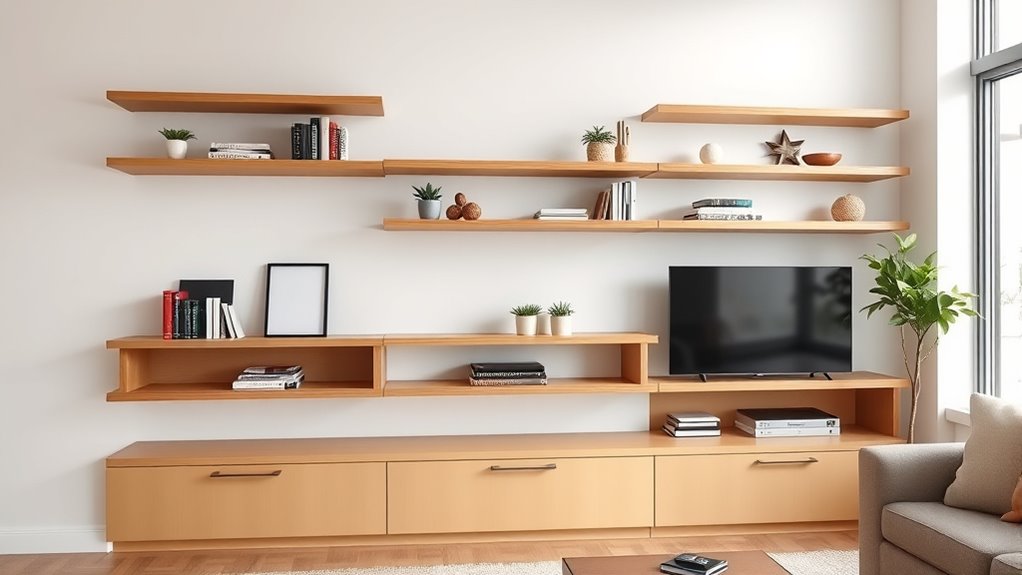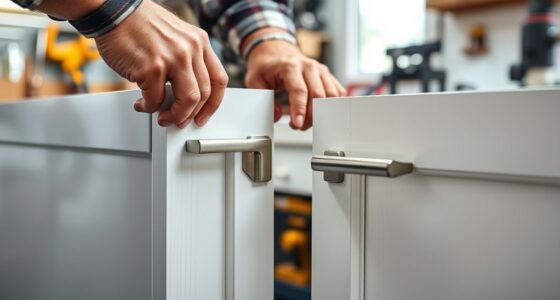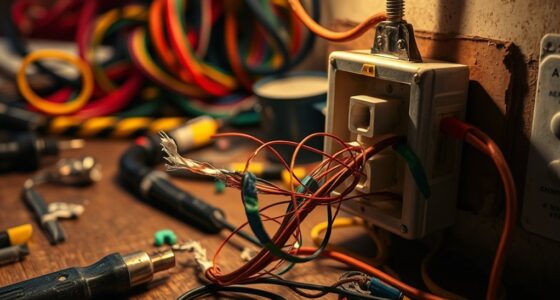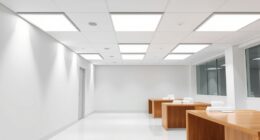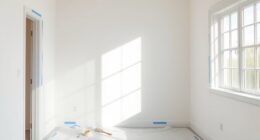To maximize space and stay organized, install floating shelves and built-in storage solutions. Floating shelves are easy to add and keep your floors clear while showcasing decor or essentials. Built-ins, like wall-to-wall shelves or recessed cabinets, seamlessly blend into your space and free up valuable room. Layering these options creates a balanced, efficient environment. Keep exploring to discover how combining these strategies can transform your home efficiently.
Key Takeaways
- Use wall-mounted floating shelves to maximize vertical space and reduce clutter in any room.
- Combine floating shelves with multifunctional furniture to enhance storage capacity without sacrificing style.
- Incorporate built-in solutions like recessed cabinets or wall-to-wall shelves for seamless, space-efficient storage.
- Install floating shelves at different heights to optimize organization and create visual interest.
- Layer storage options by integrating floating shelves, built-ins, and multifunctional furniture for a balanced, clutter-free environment.
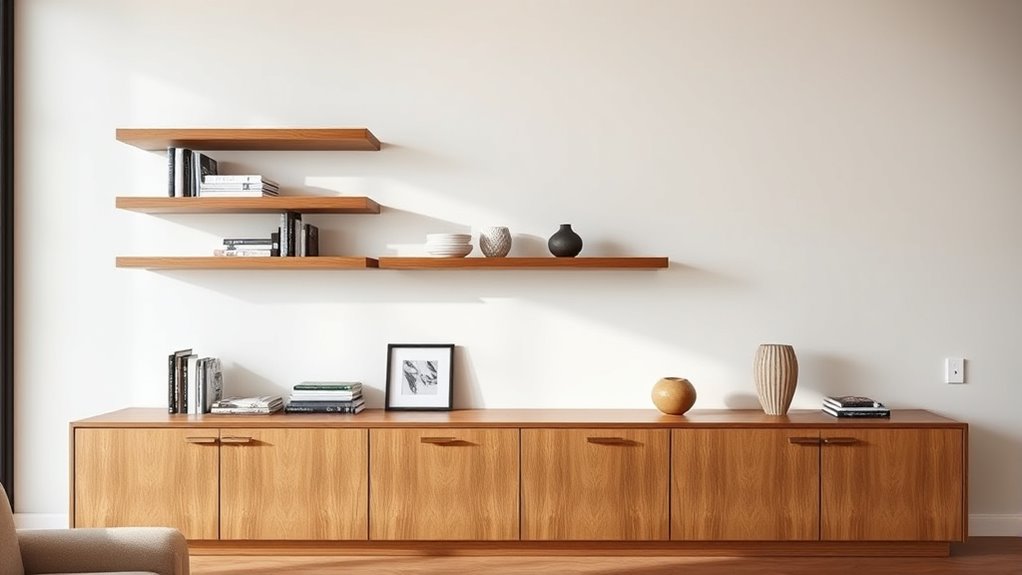
Are you running out of space and struggling to keep your home organized? If so, it’s time to contemplate space-saving storage options that make the most of your available area. Wall mounted solutions are a great way to maximize vertical space and keep clutter off the floors. Installing floating shelves offers an easy, stylish way to add storage without bulky furniture. You can place these shelves in any room—living rooms, kitchens, bathrooms—to hold books, decor, or essentials. They’re simple to install and can be customized to fit your space perfectly. With wall mounted solutions, you gain extra storage while maintaining an open, airy feel in your home. Plus, floating shelves don’t take up floor space, which is especially valuable in small or crowded rooms.
Maximize space with stylish wall-mounted floating shelves that free up floor area and add storage in any room.
Another effective approach is to incorporate multifunctional furniture into your design. Pieces like storage ottomans, beds with built-in drawers, or coffee tables with hidden compartments serve dual purposes, saving space and reducing the need for additional furniture. These items help keep your space tidy without sacrificing style or comfort. When you choose multifunctional furniture, you’re making a smart investment—each piece provides storage while seamlessly blending into your decor. It’s an efficient way to make every inch count, especially in apartments or rooms where space is tight. Additionally, understanding home organization techniques can enhance how you utilize your space efficiently.
Built-in solutions take this concept even further. Custom-designed built-ins can be tailored to fit your specific needs and maximize every square inch. Think of wall-to-wall bookshelves, under-stair storage, or recessed cabinets in your kitchen or bathroom. These are permanent fixtures that turn unused nooks into valuable storage zones. Built-ins not only help you declutter but also add a sleek, polished look to your home. They’re especially useful in smaller spaces, where traditional furniture might feel bulky or out of place. By integrating storage into your walls, you create a seamless appearance that enhances your room’s overall aesthetic.
The key to effective space-saving storage is combining these options smartly. Use wall mounted solutions like floating shelves to free up surface space, and add multifunctional furniture to serve multiple purposes. When possible, incorporate built-ins to fully utilize architectural features. This layered approach ensures your home stays organized, functional, and visually appealing. You don’t have to sacrifice style for space—these solutions work together to create a home that’s both beautiful and practical. With a little planning, you can transform even the smallest areas into organized, clutter-free spaces that feel open and inviting.
Frequently Asked Questions
What Are the Best Materials for Floating Shelves?
You should choose durable materials like solid wood, plywood, or MDF for floating shelves. These materials work well with various bracket types, such as hidden or L-brackets, ensuring stability. When selecting finish options, consider paint, stain, or veneer to match your decor. Solid wood offers a natural look, while MDF is budget-friendly and smooth, making it ideal for painted finishes. Pick based on your style and weight requirements.
How Much Weight Can Built-In Shelves Support?
Built-in shelves typically support between 50 to 200 pounds, depending on their design, materials, and installation method. Always check the specific shelf’s weight limits and follow safety considerations to prevent accidents. Reinforce the brackets and anchors into wall studs for maximum support. If you plan to store heavy items, opt for sturdy materials like solid wood or reinforced MDF, and consult a professional if unsure about weight capacity or installation safety.
Are Floating Shelves Suitable for Outdoor Use?
Floating shelves can be suitable for outdoor use if you choose weather-resistant materials like treated wood, metal, or plastic. Make sure to use proper mounting techniques, such as corrosion-resistant anchors and secure brackets, to withstand exposure to the elements. Regular maintenance helps prolong their lifespan. By selecting the right materials and installation methods, you can enjoy stylish, functional outdoor floating shelves that stand up to weather conditions.
How Do I Prevent Shelves From Wobbling?
Did you know that poorly mounted shelves can wobble up to 2 inches? To prevent this, make sure you use the right mounting hardware and anchor into wall studs for maximum durability. Check the wall stud’s strength before installing, and tighten all screws securely. Using heavy-duty anchors and double-checking your measurements can make your shelves sturdy and wobble-free, giving you a safe, reliable storage solution.
What Tools Are Needed to Install Built-In Units?
To install built-in units, you need a drill, screwdriver, level, measuring tape, and a stud finder. First, locate the studs and mark the placement. Use your drill to insert mounting hardware and drywall anchors where studs aren’t available. Secure the built-in units with screws into the mounting hardware, guaranteeing everything is level. These tools help guarantee a sturdy, safe installation that won’t wobble or come loose over time.
Conclusion
By adding floating shelves and built-ins, you transform your space into a well-organized oasis, making the most of every inch. These solutions are like clever puzzle pieces fitting perfectly into your home, maximizing storage without clutter. With a little effort, you create a functional, stylish environment that feels open and inviting. Embrace these space-saving ideas, and watch your home become as efficient as a well-oiled machine, all while maintaining its charm and comfort.
